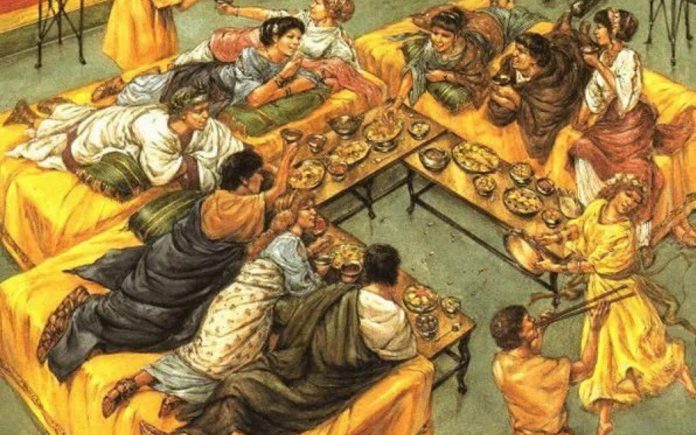
By Tiar’a Literary & Illustration
The cold and frosty months of winter (at least in the northern hemisphere) are typically filled with warn fuzzy clothing, burning fireplaces, gift-giving, festive cheer, and of course – lots of tasty food. It’s become a tradition passed down for generations, fueled by heavy commercial influence. Who of us in the United States doesn’t think of Christmas trees, twinkling lights, gifts, turkeys, and stuffing come near or around October every year? This begs a question. When and where did all this feasting and celebration begin?
To understand anything in life more comprehensively one must reflect upon its source, and eye-opening epiphanies, albeit revelations will follow.
The earliest accounts of feasting date to the Sumerian culture who dwelled upon the earth from 3000-2350 BC [Before Christ]. Their feasting had to do with a Sumerian myth, in which one of the Sumerian’s false gods “Enki” offers the false goddess “Inanna” butter cakes and beer [similar as in the novel of Harry Potter if you ask me]. Homer, the Greek poet, and author whose record dates to the 8th century BC, depicts many feasts contained within the pages of his writings in The Iliad and the Odyssey. In the United States in 1621, Pilgrims celebrated the first Thanksgiving feast, or “first harvest”. Accounts suggest that the Pilgrims [supported by Native American Indians] reaped crops and raised animals throughout the year and then feasted bountifully. Most importantly, feasting is discussed within the pages of the Holy Bible with a special attention focused upon “the last supper”.
The concept of gatherings and the “breaking of bread” dates back thousands of years, and we can be certain that it dates back farther still. After all, every human needs to eat. Without food (good healthy food that is) our bodies simply cannot survive. However, the concept of “feasting” and “celebrating” as it was known throughout the ages has over time been modified. Take this into consideration; Thousands of years ago, humans harvested and hunted for their own food. They couldn’t get into a car, drive to a grocery store, and purchase the many varieties of processed delectable sugary treats and soda. This brings us to the modern annual concept of holiday celebration and feasting.
It may shock many of you to know that the origins of Christmas stem from pagan revelry.
The Roman Empire celebrated two holidays beginning near or around the year 336. Both holidays were celebrated during the month of December. The first celebration was dubbed the “Saturnalia”. You’re probably wondering, what is the Saturnalia? The Saturnalia was a two-week mad house event during which time Romans, who brutally tortured and crucified our Lord and Savior Jesus Christ honored one of their false gods of Saturn. On December 25th (specifically), the Romans celebrated the birth of “Mithra”, their false sun god. Both celebrations included “raucous gluttony and drunken parties”.
What about gift-giving and its origins?
Coincidently, “gift-giving” in conjunction with feasting began near or around the year 336 CE [Common Era], which as mainstream history proports, is the recorded birth date of our Lord and Savior Jesus Christ. The tradition of “gift-giving” – so we believe, is a result of the Holy Bible account of the “three wise men” or “Magi”. These men gave gifts of gold, frankincense, and myrrh to the baby Jesus. Likewise, tied to the tradition of “gift-giving” on December 25th is the story of Saint Nicholas – a fourth-century Christian Bishop who gave gifts to his local community.
Most feasts and celebrations seem to occur at the end of the year – a time to worship, be thankful, and refill one’s belly before resting for the New Year. When you consider feasting and gift-giving in those terms it makes logical sense that our distant ancestors would construct their yearly twelve-month cycles in such a manner. They toiled all year, harvested crops during the fall, gave thanks, and then rested until the New Year. The difference today – in stark contrast to those times, is that today [like the Romans] – [but this of course, is not applicable to all of us] the level of our celebrations and feasting borders upon revelry and gluttony.
It is at this time of year, due to the slowdown of businesses and vacations, that we have more time to reflect. This year I encourage you to reflect upon the truthful realities that a substantial majority of American’s are hungry – all year. Not only are they hungry, but they are also worked to the point of exhaustion and do so baring extremely high levels of stress.
Celebrations and feasting when out-of-control, sadly at times, end with someone getting into a car drunk, ending up in an accident, and in some cases being killed. The end of the year feasting and celebration is good but should always be enjoyed from the perspective of being humbly grateful, and in moderation. A focus more upon, “I am so thankful and grateful for the life I have been given”, and/or, “How might I, who has been blessed with so much, help others in need?” These delicacies should be on the menu instead of, “What new gadget or video game do I want for Christmas”?
Tiar’a Literary & Illustration, is a privately owned Coachella Valley business producing engaging and informative content for individuals and business in the form of promotion, marketing, books, ads, blogs, articles, product description, publicity, and media commercials. Email us your business inquiry today at: tiarapublications@gmail.com.
“We create content for individuals and businesses worldwide”










































